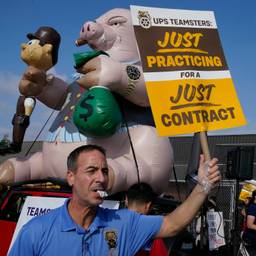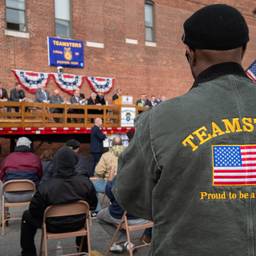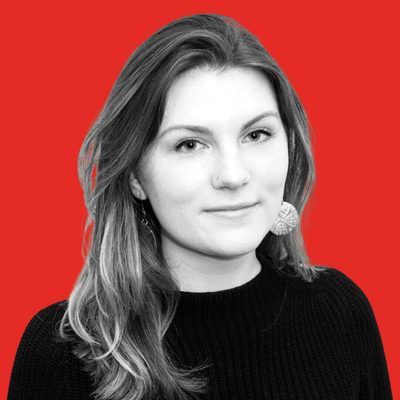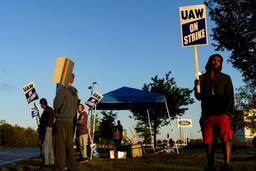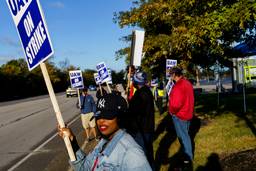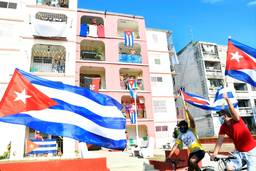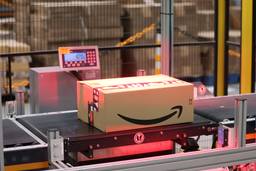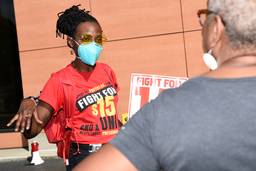UAW Turns Up the Heat on the Big Three
“If we don’t do this now, we won’t have another opportunity.”
Teddy Ostrow and Ruby Walsh
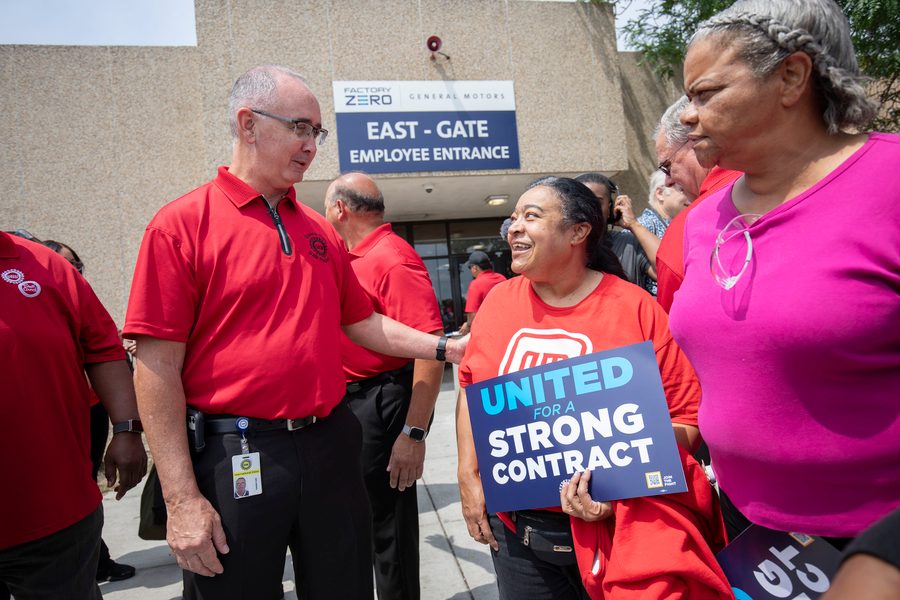
Read the full transcript below.
The United Auto Workers’ contract negotiations at the Big 3 automakers – Ford, GM, and Stellantis – just began. Their current labor contracts expire in mid-September, and the new UAW leadership has been crystal clear: they’re not afraid to take 150,000 of its members out on strike if their demands aren’t met. This would be less than two months after the potential strike of 340,000 Teamsters at UPS.
In this bonus episode, we discuss the renewed militancy of the UAW, and the reform movement, Unite All Workers for Democracy (UAWD), which shocked the labor world for taking control of the union leadership earlier this year.
There is no labor movement resurgence without the resurgence of labor in manufacturing, but the UAW has also been a leader in the upsurge of higher education organizing over the past five years.
To discuss all this, we spoke with two newly elected UAW officers: Brandon Mancilla, Director of UAW Region 9A, and Dan Vicente, Director of UAW Region 9.
This transcript has been edited for length and clarity.
Brandon Mancilla: We don’t want to just simply win a union. We wanna win strong unions. And strong unions need to be democratic, they need to be transparent, they need to be participatory.
Daniel Vicente: We have to put our foot in the ground. Now, if we don’t do this now, we won’t have another opportunity.
It’s gonna have to be us. And if you are in a shop and you feel that your local elected officials don’t represent you, run against them.
Teddy Ostrow: Hello my name is Teddy Ostrow. Welcome to The Upsurge, a podcast about UPS, the Teamsters, and the future of the American labor movement.
The Upsurge is produced in partnership with In These Times and The Real News Network. Both are nonprofit media organizations that cover the labor movement closely. Check them out at inthesetimes.com and therealnews.com where you can also find an archive of all our past episodes.
You are listening to a public bonus episode of The Upsurge. Bonus episodes are normally exclusive to our Patreon supporters as well as Teamsters who freely receive bonus content.
They are more quickly made, getting out interviews and even some on the ground reporting to our patrons.
If you listen and appreciate the show, you’ve got some extra money to share, please head over to patreon.com/upsurgepod. If you contribute $10 per month, you’ll get exclusive show notes. If you contribute $20 per month, you’ll gain access to all our wonderful bonus episodes. But really, any contribution will help. This podcast takes a lot of work, so if you can spare a few bucks a month, it will make a world of difference.
Onto the show.
For this bonus, I interviewed Brandon Mancilla and Daniel Vicente of the United Auto Workers union.
You may have heard that contract negotiations between the UAW and the Big 3 automakers, that’s Ford, GM and Stellantis, will begin this week and next. These contracts cover 150,000 auto workers. The headline story has been: UAW president Shawn Fain opted to skip the traditional, kick-off handshake between union officials and the auto executives.
Here the union isn’t just being petty. It’s symbolic of a deeper change we’ve seen at the UAW in the past year. With the election of new leadership, pro-business attitudes and concessions have given way for militancy and promises to return the legendary union to its fighting roots. That includes a willingness to strike the Big 3 after their contract expirations, just a month a half after the Teamsters may strike UPS.
Sounds familiar, doesn’t it? The Upsurge is largely about the militancy that has once again risen in the Teamsters union following a leadership overhaul in 2021. That didn’t come out of nowhere. The reform organization Teamsters for a Democratic Union played a key role in that recent shift, and prior shifts as well.
I invited Brandon and Dan on the show today to talk about their analogous group in the UAW. That’s the Unite All Workers for Democracy caucus, or UAWD, which was largely modeled on and supported by TDU. We talked about it a bit in episode 5 with Barry Eidlin.
Following corruption scandals in their union, UAWD fought for a member referendum to instate one-member one-vote elections of top officers in the union. Democracy, in other words, like in the Teamsters.
Union members overwhelmingly approved of this change, and in the 2022 and 2023, in the union’s first direct election, all UAWD-backed candidates won their races, including for the presidency. Dan and Brandon were among those elected.
The militant developments we’re seeing then, are a direct result of rank and file organizing for reform in the union.
And the stakes are very high. The new leadership wants to abolish tiered contracts, which again sounds familiar. But they also want to regain cost-of-living adjustments and better pensions for their members, and to unionize the burgeoning electric vehicle and battery industries.
There is no resurgence in the labor movement without a resurgence in the manufacturing sector.
Something we also talked about in this interview is the role of the UAW in the higher education union drives that are seeing an upsurge across the US right now.
But that’s enough context. I’ll leave the rest to Brandon, Director of UAW Region 9A, and Dan, Director of UAW Region 9.
Brandon Mania and Dan Vicente. Thanks for joining me on The Upsurge.
Brandon Mancilla: Thanks for having us.
Daniel Vicente: Yeah, it’s a pleasure to be here.
Teddy Ostrow: So I invited you guys on because I wanna talk about union reform movements here, but first, can you both introduce yourselves? How did you come into the union?
What jobs have you had? What are your roles right now?
Brandon Mancilla: I started off as a research assistant and teaching assistant at Harvard University. So I am part of the higher ed organizing wave that’s really taken off over the past five to 10 years. Lots of higher ed workers in the UAW. I’m sure we can talk more about that. Harvard University had a first union election in 2016, which we lost. But then the NLRB invalidated the election because Harvard left lots of people off the eligible voter list. We won our second election. I became more involved through that. We had a strike in 2019 for our first contract. When we settled the contract, I became local president.
We also continued to fight for a stronger successor contract. We went on strike again, so it was a long, bloody fight to win the contracts we won at Harvard University for approximately 5,000 student workers. After that I became an organizer in the legal services and nonprofit sector of the UAW, and then was crazy enough to run for a Region 9A Director, which is the Northeast and Puerto Rico. So that’s how we ended up here.
Daniel Vicente: I’m Dan Vicente. I come from a marine manufacturer out of Pottstown, Pennsylvania, UAW Local 644. I got involved in my local union because I was exposed to chemicals at work. After I came back from the emergency room, I brought those safety concerns to my shop chairman and he told me it wasn’t his effing problem, so I ran against him as soon as I could. Then I won that election and then I’ve just been running for every position that I could ever since. I got my first union job in 2017 after I exited the United States Marine Corps in 2012 and was just kind of going from job to job, from then until I got the UAW job — the benefits and wages of that union job was able to settle my life down and gimme a path forward. I got involved in the reform movement of the Unite All Workers for Democracy after I found out about the one-member one-vote campaign, which was born out of the corruption probe that the Justice Department started on the union, and has sent many of our top officials to federal prison.
That was outrageous, obviously, and I got involved because I was mad and I just thought, we can’t be fighting companies and fighting our own internal leadership. So I figured I’d throw my name in the hat just to show the incumbency that we weren’t gonna take it anymore. Like Brandon said, I was crazy enough to do it and we ended up winning.
So that’s how I ended up in this position.
Teddy Ostrow: Hell yeah. So, as I said, we wanna talk union reform, or more than that, really, labor’s revitalization — union reform within this broader labor moment that we’re seeing. The Teamsters shifted leadership right in 2021. UAW just did, including the election of you guys and other people who came out of your caucus, your slate. So I wanna start out with, what is Unite All Workers for Democracy, or UAWD for short? You started to talk about this, but why did it emerge? What have you guys pushed for, what have you achieved it and where is it going?
Brandon Mancilla: UAWD is the effort by rank and file workers in the UAW to democratize and reform this union. There’s been a long history of reform efforts to make the union more militant, to be anti concessions and keep leadership and staff accountable to the rank and file membership for decades.
We can go back to the ‘70s shop floor struggles, to the ‘80s and ‘90s New Directions movement, and a lot of the veterans of those struggles founded UAWD in the late 2010s and into this decade. Because it became unsustainable, the levels of corruption.
It was really a shameful period in the history of our union when it was exposed that the top leadership was stealing membership dues. So combining that with the history of concessions that were made that affected the livelihoods of our members across sectors, but especially in the auto and manufacturing sectors of the union.
UAWD emerged as a response to that. So with the DOJ investigation and requirement of a referendum for one member, one vote, UAWD as a reform caucus was ready and primed to really organize around winning those. So in 2021, we won that referendum. The choice was [between keeping] this outdated delegate system at the convention where handpicked delegates decided who the leadership was, or we would go to one-member, one-vote, and every member would have the opportunity to directly voice who they wanted to be their regional directors, who they wanted to be their president, vice president, secretary, treasurer, et cetera. So that’s what we achieved so far. In 2022, our reform slate ran seven people as Members United, a combination of vice presidents, secretary, treasurer, and regional directors. We also had an independent run, but also a reformer, for regional director in Ohio and Indiana. And we all won. Dan and Shawn went into a runoff after the first round.
I won in the first round and Shawn and Dan also were victorious, so everybody we ran, won, and now forms a majority on the international executive board, which was unthinkable just months ago, but even like when UAWD was formed in 2019.
Daniel Vicente: Like Brandon said, the Unite All Workers for Democracy movement, a lot of the people that helped found that are seasoned veterans of the reform movement. They’ve been fighting the good fight for decades on their own, more or less, as like these one man, one woman islands. I think that the upsurge, in just, our involvement kind of is a few things. One of ‘em is like, Brandon and I are millennials, right? We have been told most of our lives that we live in the best country in the world, and that if we just pull ourselves up by our bootstraps and work hard, that there’s a path to middle class life.
And it just doesn’t exist anymore. It was easy for us to say that’s because of our employers, but with the corruption probe laid bare to all of us, coupled with the pandemic, it’s easy to say that it’s just the employer’s fault, but it was the UAWs fault for the situation that we were in as well.
The UAW had taken a business/management friendly style of unionism, and our members are not down with that anymore. We are angry. We are due increases and we made sacrifices during the recession to save these institutions of American manufacturing with the understanding that when the emergency was over, that they would get us back, make us whole again, and get us back where we used to be and that that has never happened. We’re not gonna continue going forward in just accepting that.
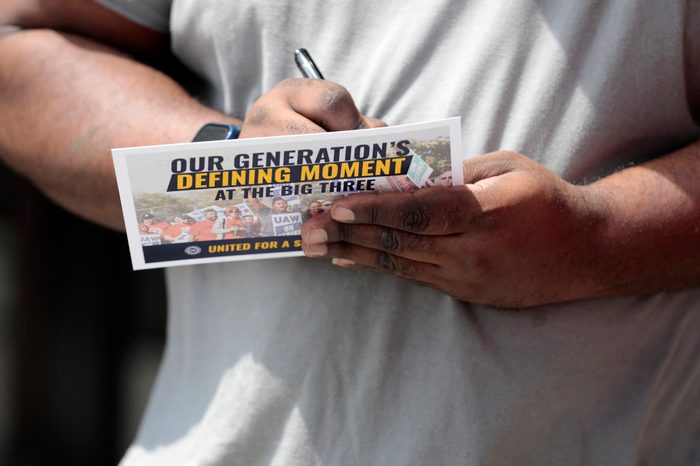
Teddy Ostrow: So an important piece of this is the UAW mandate, and winning some kickass contracts in manufacturing. Probably the most urgent are the contracts for the so-called big three automakers, Stellantis, Ford, and GM. Maybe you guys could help us understand what’s coming in September?
What are you guys doing to prepare? What are the stakes of this fight and of broader organizing in manufacturing and auto, which does seem to be taking an electric turn right now, with huge investments by battery and auto companies.
Dan, maybe we can start with you. You did mention some things that you guys are fighting for, and fighting against, that have, I think some resonance with the Teamsters as well.
Daniel Vicente: Yeah. These negotiations are arguably the most important in generations. The transition to electric vehicles is happening whether we want it to or not.
It’s happening, so the upcoming negotiations are massive. What we’re doing currently is we’re going through the regions and we are trying to prepare our members for legitimate strike actions. To be very honest with you, it was laid bare during the pandemic that we were all deemed essential, but all of our management could go home. You’re not essential. You need us more than we need you.
What is similar to the Teamsters — the tiered wages are a wedge that was driven into our union. We can no longer accept this. You cannot work next to somebody doing the same exact job on an assembly line and make $10, $12, $15 less than that person. It is not a sustainable model.
The companies are not in financial distress. They’re making money. We are not asking to be made millionaires overnight. We are asking for a path to middle class American citizenship in this country. The jobs that used to exist that allowed our blue collar working class people to sustain themselves and their family no longer exist.
I’ve been in this position for three months. I was just on the shop floor. I was just working in a factory. I had people coming in the door making $16 an hour, having to get EBT cards, which, there’s nothing wrong with having to get assistance, but you have a union job and you have to get EBT to feed your families — it’s not acceptable.
We are not going to continue down this path while CEOs are making tens of millions of dollars and our people are having to get government assistance just to feed their families. It is not a sustainable model. In the past, the union, in my opinion, has taken a stance that they need to work together with the companies.
Under our new leadership, our stance is we are responsible partners in this relationship, but we are not going to force our people to take concessionary contracts. When you are making money, it’s not going to happen. The institution of the union doesn’t exist simply to propel itself. It exists to fight for the men and women that work the floors and drive the trucks and make the products and provide the services that make this country go.
Nobody is coming to save us. The Democrats aren’t coming to save us, and the Republicans aren’t coming to save us. It’s gonna have to be us. It’s gonna have to be us. The people listening to this now, it’s gonna have to be you. Because Sean O’Brien can’t do it himself. Shawn Fain can’t do it himself.
It’s gonna have to be us.
Brandon Mancilla: Yeah. Shawn Fain and the top officers on the executive board had the first ever virtual town hall with the UAW membership a couple of weeks ago, and they made it very clear that the big three auto companies, Ford, GM and Stellantis made a quarter of a trillion dollars over the last decade. So there should be no talk of a cost neutral contract. There should be a contract in which our members are making gains and benefiting from the profits that they themselves created through the work that they do. So we are being very clear in our messaging and our preparation for this contract fight.
It’s up to the companies to prevent further strike action. So we’re gonna have to end tiers. Tiers divide workers, give them different benefits, different pay for doing the exact same work, standing right next to each other, oftentimes; to reinstate COLA, implement stronger job protections, especially as this [electric vehicle] transition does threaten thousands and thousands of jobs of our members. And an increase in pensions for retirees. Retirees built this union and they have not seen any increase in many years. So this is something that we have to, for the sake of our, our union, for the sake of the labor movement, for the sake of, I think the working class as a whole, the UAW has so much potential to really reshape the labor movement and the conditions of workers who are also non-union, and also to continue organizing.
How are we going to be able to continue organizing in manufacturing in so many sectors if our contracts are tiered? If our contracts don’t have COLA, if our contracts don’t show that you’re gonna be making more than minimum wage or close to minimum wage, that’s something that’s unacceptable and something that with a union contract, we need to be doing better on.
I think what Dan touched upon is really essential. It’s not gonna be just Shawn Fain and the vice president’s going into a room and figuring it out, and then coming back and saying, “Here, take this deal.” It’s gonna have to be a legitimate struggle, a legitimate contract campaign. Shawn’s committed to not having backdoor secret negotiations, communicating constantly with the members about these negotiations and updating them and communicating constantly.
But that also means involving them, right? Having locals take action to prepare for these campaigns, making sure everyone knows what the demands are, making sure we’re talking with members and having rallies and parking lot conversations so that everyone is constantly aware of where we’re headed and not just in the dark until a TA is reached.
Teddy Ostrow: Thank you so much for unpacking that. I wanted to move on to what many listeners probably know by now, which is that the UAW doesn’t just organize auto or manufacturing workers, right?
They’ve organized a large number of higher education workers, for some time now actually. So Brandon, this is your industry, for people who might ask why the UAW is in higher education. Can you help unpack that a little bit and explain why you think we’re seeing so much activity in the sector? It might be one of the places where we could say there is a legitimate upsurge going on — lots of strikes, lots of organizing right now.
And sorry for the long question, but, I am also curious about how both of you think about the strengths or the dynamics of having seemingly different types of workers, “blue collar” versus “white collar” workers in the same union.
Brandon Mancilla: I think the important thing to say first is that the UAW has always been a diverse union in terms of sectors. It started off as an auto worker union, obviously, but very quickly started organizing in aerospace and military production, office professionals, and then expanded into gaming and expanded into public sector workers.
So it’s always been a union that represents more than just auto workers. Higher ed also has a longer history. I think there was a real push by office and clerical staff and secretaries to organize at universities, in the ‘70s and ‘80s. Then quickly after that, student workers and faculty also began organizing.
So the University of California, the University of Massachusetts, have been in the UAW since the 1990s. So that’s definitely not as recent as it may seem. But what really changed was the Columbia decision of 2016 which allowed student workers at private universities to organize and collectively bargain.
So since 2016 with the Columbia decision, Columbia University student workers, Harvard University student workers, and then everyone else right? That wave, it’s exploded to the point where, it’s almost a given that the minute an organizing drive takes off, it’s going to win.
My election at Harvard, our two elections were a real, real fight to win. Now elections are winning 80, 90% margins, right? It’s like employers are just forcing elections to buy time because they can’t actually beat the drive anymore. It’s taking off because like so many other sectors and so many other workers across the country, it’s an industry that is facing an existential crisis.
Working conditions are collapsing. People have little job security. They don’t know what they’re looking forward to anymore. In higher education specifically, especially for postdoctoral researchers and adjuncts and student workers, we’re facing a situation in which, it’s neither a stepping stone into a career that is gonna be more secure, nor is it a career in itself that’s sustainable.
So we have to actually organize to make those jobs that have union protections and COLA and strong health insurance and retirement packages, et cetera. So I think that’s what the struggle is. It’s actually acknowledging that so much work goes into sustaining and actually educating and researching in this country, and also taking control over the future of what higher education looks like, beyond just the bread and butter issues that our members are fighting for. We’re also trying to change the culture at these higher education institutions that have protected abusers, have protected people who have no problem taking advantage of workers in very precarious situations. And also pushing for education to be a public good, to make it free in this country and a universal right that people, if they want to, can benefit from. This is a worker led push. So the UAW has invested and made this a priority.
I think since so many of us have been in first contract, campaigns and organizing campaigns, we saw firsthand what the limits and the problems were with the UAW: where we lacked resources, where we lacked proper support, where the concessionary ideologies came from and we pushed back against that really hard.
At this point, I think that’s why a lot of higher ed workers have gravitated towards reform in large numbers because we don’t want to just simply win a union. We wanna win strong unions. And strong unions need to be democratic, they need to be transparent, they need to be participatory.
That’s something that aligns very much with the reform movement of the UAW amongst manufacturing workers.
Daniel Vicente: Yeah. So it has been eye opening to get involved with the higher education people and honestly, the experiences that they’ve had on their first drives, they’ve been able to bring that and teach us in the manufacturing field because we’ve been long established, manufacturers and leadership had grown stagnant. These higher education guys brought an energy and a level of knowledge to us that allowed us to organize better so that when we went into our constitutional conventions, we knew the rules and processes and how to get things passed. It’s been amazing to get to work with Brandon, but also student workers from California, all over the country, just because there’s so much opportunity for us to teach one another. In Detroit we had a session where the higher education workers allowed the manufacturers to come in after hours and we were able to listen in and kind of hear the issues going on with them.
And a lot of the differences between us were just language differences. We just call things, different things in manufacturing, like we know what whipsawing is. It just called something else in higher ed. The issues that they’re going through sound very similar to ours.
Particularly I remember being shocked hearing from the student workers in California and the grad students about how they work for these universities and then they live in university housing and then immediately have to pay back their wages to the university. It sounded exactly what the mine workers were going through in the 1920s, having to get paid scrip and, and it’s outrageous.
So the bridges that we’re building across sectors right now are amazing. We have so much to learn from one another, and it’s providing us information that we can use at the table across all sectors coming up. What appears to have happened is the UAW made a push about 10, 15 years ago to try to organize down south in the foreign automakers. And that did not go well. And then they reinvested in organizing higher education, and that has been massively, just overwhelmingly positive for us. We have a drive currently in my region, the University of Penn in Philadelphia, which we are very confident will be successful and would bring about 4,000 members into the region.
So we’re pushing it everywhere, and those are just a few drives and it’s been just great to work across sectors with my fellow workers and learn what’s going on with them, not just in higher ed, but in aerospace and agriculture. It’s been amazing.
Teddy Ostrow: I so appreciate hearing that because I think that there are often very bad faith arguments made to try to pit workers against one another, but really in the end, people are looking for similar things, the same things.
To wrap this up, I just want to give you guys a chance to speak to anything we haven’t touched on that you think is important to get out there to the Teamsters and, and to non Teamsters alike.
Daniel Vicente: If Teamsters are listening to this, while I was running this campaign for leadership in the UAW, I was pulling 10 hour shifts in a factory and I was working in the UPS warehouse in Westchester, Pennsylvania on a sorting line.
That job is brutal.
It was effing brutal. The struggle for Teamsters is the same struggle we’re going through in the UAW. If you’re listening to this, like I said, briefly earlier, we’re under attack.
The working class in this country is under attack and we are tired of being paid lip service by one party or the other. I have no faith in either of them to come and save us. If you’re listening to this, it’s because you are interested and you care about what’s going on in your workplace as well.
And you see the injustices and the unfair system that we live in and we work in, and it’s gonna be up to us. We have to put our foot on the ground. Now, if we don’t do this now, we won’t have another opportunity. I am every day following what’s going on with the Teamsters, and it gives me so much strength and it fills my heart with pride.
We run this country, we make the money for these corporations. We’re not asking them to turn us into millionaires overnight. We’re asking them to allow us a path to live in the middle working class. That’s it. An insult to a Teamster, an attack on a Teamster is an attack on a United Auto Worker, a longshoreman.
All of ‘em. All of them.
We have to stand together in this country if we want to fight and get back what is due to us. The only way that’s gonna do that is with you listening, getting involved, talking to your coworkers. Like I said, I love Shawn Fain and Sean O’Brien. These dudes get me so worked up. But they can’t do it all on their own.
It’s gonna have to be us. And if you are in a shop and you feel that your local elected officials don’t represent you, run against them. Brandon and I are absolutely examples that it’s not impossible. Get involved, go to your local union meetings, run for whatever positions you can. This is up to us.
No one’s coming to do it for us. They’ve told us that there is no savior coming. You and I are gonna have to link up and we’re going to have to fight this fight not just for ourselves, but for our kids and for the future. And if we don’t do it now, corporate America will grind the middle class into nothing.
Brandon Mancilla: I also add to that, I think the UAW is going to be organizing. We need to grow the labor movement in order to build power. So if you are listening to this and you are not a member of a union, I think it’s essential for this to be the moment that you consider unionizing and, and reaching out to us or any other union that you think would fit your, your workplace.
So it’s extremely important that we’re fighting to improve the working conditions and the lives of our members who are already members of our union, but we are also looking to organize the rest of the unorganized working class. I’ll also say that, there’s been a lot of talk about, Shawn Fain’s non endorsement of Joe Biden, and I think I just wanna make it clear that the reason we’re doing that, and the reason Shawn Fain decided to withhold his endorsement for now, is that we want commitments from the White House, from elected officials, that you’re not just gonna give us lip service, like Dan said, you’re actually gonna stand with us if we have to go on strike. You’re gonna stand with us on the bills that will protect our jobs, that will improve our working conditions and organizing conditions for the labor movement, and not just saying that support unions.
Joe Biden’s done a number of good things for the labor movement. But he also stood in the way of the railroad workers. Shawn Fain fully believes that that was a test of the White House. With the Teamsters UPS negotiations going on and big three negotiations coming up, that’s another test for our elected officials, not just for Joe Biden.
So next time they come around asking for our endorsements and support in elections, there’s gonna be a scorecard. How’d you do in supporting us as we went out after these companies to win stronger contracts?
So that’s the position we’re taking and it’s a strong one. It’s one that I think more unions should take, should be less afraid of, of taking real direct stands about where the labor movement is in relation to Democrats. But you know, I think part of growing the labor movement is having a political stance.
Teddy Ostrow: Brandon Mencia and Dan Vicente, thank you guys so much, for coming on The Upsurge.
Daniel Vicente: Thanks for having us. Yeah, thank you for having us, and if the Teamsters go out, we’ll be on your lines as well.
Brandon Mancilla: Absolutely, solidarity.
Hosted by Teddy Ostrow
Edited by Teddy Ostrow
Produced by NYGP & Ruby Walsh, in partnership with In These Times & The Real News
Music by Casey Gallagher
Cover art by Devlin Claro Resetar
**
Support the show at Patreon.com/upsurgepod.
Follow us on Twitter @upsurgepod, Facebook, The Upsurge, and YouTube @upsurgepod.
***
Show Notes
- Chris Brooks, ”How the UAW Went from a Militant, Trailblazing Union to a Corrupt, Dealmaking One‚” In These Times, March 5, 2020.
- Luis Feliz Leon, ”‘There’s a Real Fight Coming’: Newly Elected UAW Reformer Daniel Vicente on What’s Next,” In These Times, March 8, 2023.
- Alex N. Press, ”Can the UAW Rise Again?” Jacobin, March 31, 2023.
- Becca Roskill, ”The End of Business Unionism at the UAW — and Beyond?” The Nation, April 7, 2023.
- Teddy Ostrow, ”Workers Are Transforming America’s Most Powerful Unions into Fighting Machines. Yours Could be Next‚” The Real News, June 26, 2023.
- UAW Video: ”Fighting for COLA”
- UAW Video: UAW Unionwide Town Hall on the Big Three Automakers
- UAW Video: ”Our Defining Moment‚” Calls out Big Three Race to the Bottom in EV Transition.
- UAW Video: ”¼ Trillion”
Teddy Ostrow is a journalist from Brooklyn covering labor and economics. He is the host of The Upsurge podcast and his work has appeared in The Nation, The New Republic, and elsewhere. Follow him on Twitter @TeddyOstrow.
Ruby Walsh is an audio producer from Brooklyn. She is a co-producer of The Upsurge podcast and a development producer for Giant Grin LLC. Formerly, she was the associate producer of Moyers on Democracy and wrote for BillMoyers.com.
